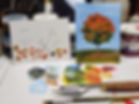Watercolour vs Acrylic Paint: A Guide for Beginners
When starting out with art, it can be hard to decide which paints to use and what will be easiest to learn. Acrylic and watercolour paints are two amazing mediums to paint with… but which one is the ultimate beginner’s paint? Both create beautiful work, but when it comes to mess and mistakes, there are clear pros and cons to each medium.
What’s the Difference Between Watercolour and Acrylic?
Acrylic and watercolour paints are very different, and using each one will give your painting a different visual quality. Where acrylic is thicker, bolder, and more permanent, watercolour is thinner, softer, and more delicate.
Watercolour Paint

Watercolour is a paint that is meant to be watered down and applied to watercolour paper in thin translucent layers. Since the layers of paint are thinned out, you must apply light colours before dark colours, because the light colours are not strong or opaque enough to cover the dark ones. The paper is used as the highlights or light areas within watercolour paintings. Watercolour paintings are usually soft and work with water to create interesting blends.
Properties of Watercolour Paint
Watercolour Properties
Transparent pigment
Comes in solid blocks or tubes
Must be used with watercolour paper
Uses very little paint and mixed with water
Can be combined with gouache
Can be resisted with wax or oil pastel
Pros of Watercolour Paint ✅
Easy clean up; palettes can be wiped clean with water
Doesn’t stain easily
Compact and portable
Less waste: dried paint can be reconstituted with water
Cons of Watercolour Paint ❌
Difficult to control paint application
Mistakes cannot be easily painted over
Watercolour paper can be expensive
Artwork is delicate and easily damaged
Watercolour pigment can wash off of most surfaces and doesn’t usually stain. It is also easy to bring your paints with you because you can purchase them in small travel kits with solid colour blocks or in very small tubes! Since watercolour paint is transparent, mistakes cannot be easily covered up with more paint, especially the light colours. It may also be difficult to control the paint on the paper at first, but with time and experience, that control can be learned!
💡 Additional tip: Watercolour that is white is actually a paint called gouache, which is a thicker, opaque watercolour that can be mixed to tint and cover transparent colours.
Acrylic Paint

Acrylic paint is a thicker, more opaque, and more vibrant paint to work with. It can be applied to many different surfaces like canvas, wood, and paper. It is a fast drying paint, but allows for some blending while it’s still wet. You can use acrylic straight out of the tube, or mix it with a bit of water to dilute it a little. You can even add a variety of mediums to acrylic paint to change the texture, drying time, and properties of the paint.
Properties of Acrylic Paint
Acrylic Properties
Opaque pigment
Can be used for 3D texture like impasto
Permanent (dries into a flexible plastic)
Can be mixed with acrylic mediums for different properties
Suitable for mixed media
Pros of Acrylic Paint ✅
Durable and creates long lasting art
Mistakes can be easily painted over
More versatile (can be used on many different surfaces)
Inexpensive to start
Cons of Acrylic Paint ❌
Acrylic paint stains are permanent
Requires more materials
More waste: dried paint and palettes cannot be reused
Requires more materials
Not easily portable
Acrylic paint dries into a flexible plastic, so it creates art that lasts a very long time. When completely dry, acrylic paintings are durable and resistant to staining, even if it is displayed without glass. Since acrylic colours are opaque and the paint is naturally thicker, it’s easy to paint over mistakes and fix errors. Unlike watercolour paint, acrylic paint stains any surface that it dries on. It also requires more paint in general, along with other mediums and materials, since each paint colour comes in a separate paint tube.
💡 Additional tip: Buying larger tubes of essential colours is a much better choice than buying lots of different colours in small tubes because it leads to less waste and a better understanding of how to mix colours. We recommend starting with 5 essential colours (then add more if you need): white (large tube), black, primary red, primary yellow, and primary blue.
Is Watercolour or Acrylic Paint Better for Beginners?

Instructor Arruniya Mohendran teaching a virtual watercolour class for kids
Acrylic and watercolour paint are both amazing mediums for beginners for different reasons. They achieve very different styles and allow students to learn new techniques with both. Acrylic paint offers a way for beginners to create without the pressure of messing up, while watercolour allows for beginners to have a fun painting session without worrying about mess!
Start with watercolour if…
You’re more patient and like to plan out your painting process
You prefer a clean and minimal workspace
You prefer to paint on paper instead of canvas
You like to paint outdoors / plein air and need something portable
You’re more likely to take care of delicate artwork

Student artwork in watercolour from art camp
Start with acrylics if...
You’re more experimental instead of methodical
You don’t mind a messy workspace or permanent stains
You want to use mixed media such as collage
You want to add heavy texture in your artwork
You like painting on different surfaces other than paper

Student artwork in acrylic from acrylic painting class
If you’re interested in learning how to paint with acrylic, or watercolour, visit our broad selection of art classes that can help you expand your skills. Browse our virtual Beginner Watercolour and Acrylic Painting classes!

Click that heart if you like this post! If you found this helpful, please help us share the knowledge with others.

.png)
.png)
.png)
.png)
.png)
.png)
